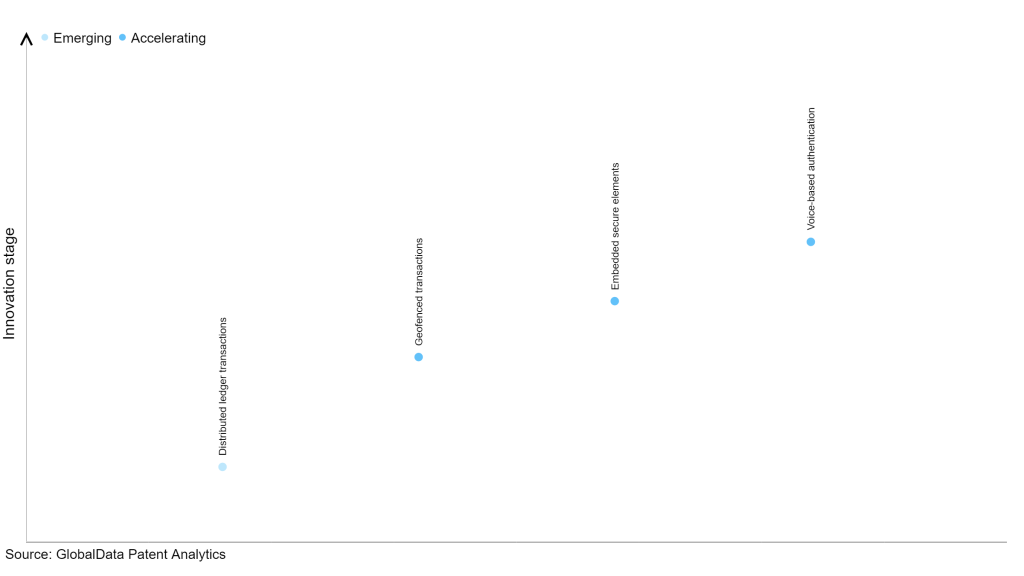The banking industry continues to be a hotbed of patent innovation. Activity is driven by digitalization, enhanced security, operational efficiency, ever changing consumer expectations, and growing importance of technologies such as artificial intelligence (AI), Internet of Things (IoT), and cybersecurity. In the last three years alone, there have been over 5,000 patents filed and granted in the banking industry, according to GlobalData’s report on Cybersecurity in banking: voice-based authentication. Buy the report here.
However, not all innovations are equal and nor do they follow a constant upward trend. Instead, their evolution takes the form of an S-shaped curve that reflects their typical lifecycle from early emergence to accelerating adoption, before finally stabilizing and reaching maturity.
Identifying where a particular innovation is on this journey, especially those that are in the emerging and accelerating stages, is essential for understanding their current level of adoption and the likely future trajectory and impact they will have.
35+ innovations will shape the banking industry
According to GlobalData’s Technology Foresights, which plots the S-curve for the banking industry using innovation intensity models built on over 176,000 patents, there are 35+ innovation areas that will shape the future of the industry.
Within the emerging innovation stage, distributed ledger transactions, is the disruptive technology that is in the early stages of application and should be tracked closely. Geofenced transactions, embedded secure elements, and voice-based authentication are some of the accelerating innovation areas, where adoption has been steadily increasing.
Innovation S-curve for cybersecurity in the banking industry

Voice-based authentication is a key innovation area in cybersecurity
Voice-based authentication is a type of biometric authentication that uses a person's voice as a unique identifier to verify their identity. The technology works by comparing the voice of a person trying to gain access to a system or device with a pre-recorded voice sample of that person on file, thereby ensuring secure access.
GlobalData’s analysis also uncovers the companies at the forefront of each innovation area and assesses the potential reach and impact of their patenting activity across different applications and geographies. According to GlobalData, there are 75 companies, spanning technology vendors, established banking companies, and up-and-coming start-ups engaged in the development and application of voice-based authentication.
Key players in voice-based authentication – a disruptive innovation in the banking industry
‘Application diversity’ measures the number of applications identified for each patent. It broadly splits companies into either ‘niche’ or ‘diversified’ innovators.
‘Geographic reach’ refers to the number of countries each patent is registered in. It reflects the breadth of geographic application intended, ranging from ‘global’ to ‘local’.
Patent volumes related to voice-based authentication
Source: GlobalData Patent Analytics
Alibaba Group is one of the top patent filers in technologies associated with voice-based authentication. It filed several patents related to methods and devices for voiceprint recognition, sound production object determination, speech recognition, and voice-based role separation. Baidu, Mastercard, and Visa, are some of the other key patent filers in this space.
In terms of application diversity, Skeyecode held the top position, while JVCKENWOOD and USAA stood in second and third positions, respectively. By means of geographic reach, Skeyecode leads the pack, followed by Microsoft and Alibaba Group.
To further understand the key themes and technologies disrupting the banking industry, access GlobalData’s latest thematic research report on Cybersecurity in Banking.
Data Insights
From

The gold standard of business intelligence.
Blending expert knowledge with cutting-edge technology, GlobalData’s unrivalled proprietary data will enable you to decode what’s happening in your market. You can make better informed decisions and gain a future-proof advantage over your competitors.







